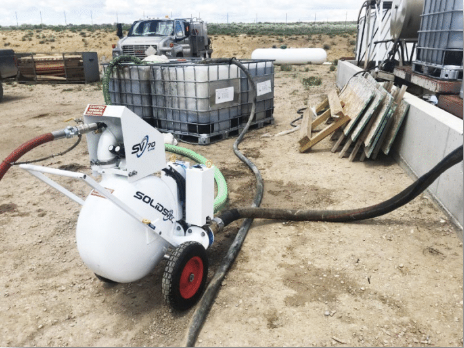VACUUM LOADING SOLIDS PUMPS - AN OVERVIEW
SOLIDSVAC - the leading provider of vacuum loading solid pumps.
A SOLIDSVAC is a combination of a vacuum generating 100% air powered venturi combined with a 316 SS pressure vessel. These, via a set of manuals and/or automatic controls, operate a variable vacuum load, pressure discharge cycle whereby any product that can pass through the hose, can be captured and transferred.
The standard SV pumps operate in two phases - Lean Phase where the material is conveyed within the air stream, and Dense Phase where the material is conveyed by the airstream. This duality of function occurs in both the vacuum loading and pressure discharge modes of operation. The new CVCD Series of pump provides virtually continuous operation in both modes - an industry first.
A Solids Pump’s performance with regards to a certain application or material is dependent on numerous factors, not the least of which is the operator and/or set-up. Below are several items that should be considered if you are to optimize the performance of a SOLIDSVAC.
BASIC TRAINING
Basic operator training in the function and operation of the pump is strongly advised. This is for both OH&S aspects, along with the success and commercial viability of the task to be undertaken.
CORRECT AIR SUPPLY
Available air, both volume - CFM/m3 and pressure - bar/psi/kpa, and using the correct diameter supply hose is crucial.
The loss of pressure brought about by either distance or insufficient hose ID, is somewhat equivalent to that of voltage drop experienced in electrical equipment. A larger diameter supply line can act as an accumulator, often saving a significant amount of energy when employed correctly.
CORRECT HOSE & MINIMAL BENDS
The length, diameter and type of hose employed has a significant effect on the achievable throughput, this applies to both suction and discharge lines. Correctly rated hoses are necessary, and preferably with a smooth bore and as few bends as the operation allows. When pneumatically conveying solids, each 90 deg bend equates to approximately 6 metres of straight hose from an energy perspective.
APPRECIATE THE ENERGY REQUIRED
At 1 Sg of a material to be conveyed in every 100mm (4”) hose, equates to approximately 1Kg or 2.2lb and as such a 5 Metre (20’) hose will carry around 60 Kg (130lb) of material. It is worth keeping in mind that it takes far more energy to vacuum convey a material than it does to push the same with pressure.
NB: Air volumes must be considered when operating above 3000 Metres or 10,000 Feet where the is thinner hence a greater volume is required to maintain the correct pressure.
KNOW YOUR MATERIAL
The SOLIDSVAC pumps will generally have no problem handling up to 5 SG material, and solids with a diameter up to 70% of the hose in use.
That said, the heavier a product is, the more you must be conscious of the other dot points. Mining, drilling slurries and similar materials convey well, although you are best served by keeping them moving to their final destination. SOLIDSVAC strongly advise that when undertaking a material transfer via pneumatic conveying, both prior and during operation, you strive to have as many aspects as possible of the operation working to assist that process.
These aspects include:
Unit placement
Type of hose
Layout
Gravity
Viscosity
Operator knowledge, etc.
NB: Polymers, or materials with the characteristics of honey, can be particularly difficult unless heated as these materials tend to absorb the energy exerted on them.
REALISTIC EXPECTATIONS
High vertical suction lifts - those lifts in excess of 10 metres/30 feet at sea level - can’t be recovered via vacuum alone, they need to be pneumatically conveyed which means the material must share the suction line with a volume of air. Be aware that although lifts in excess of 25 metres can be achieved, there can be a correspondingly significant drop in throughput rates.
SOLIDSVAC pumps are almost impossible to damage in operation, no internal workings means there is no cavitation, no wet end seal, no heat generated etc.
The units can move between vacuum loading a solid stream of viscous material to pneumatically conveying a much less viscous material via the introduction of air into the convey line.
This can be achieved by the operator, or the unit itself, and it can and will move between the two phases as the available energy and materials require hence they will pump almost anything that flows, and certainly several products that do not.
In 30 years of pumping solids, we've gained a little knowledge that we’re more than happy to share.



